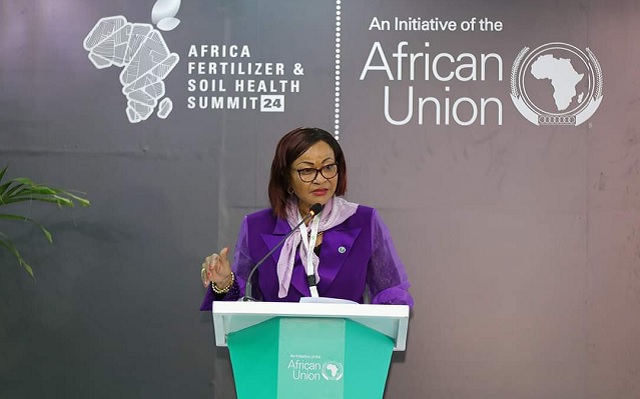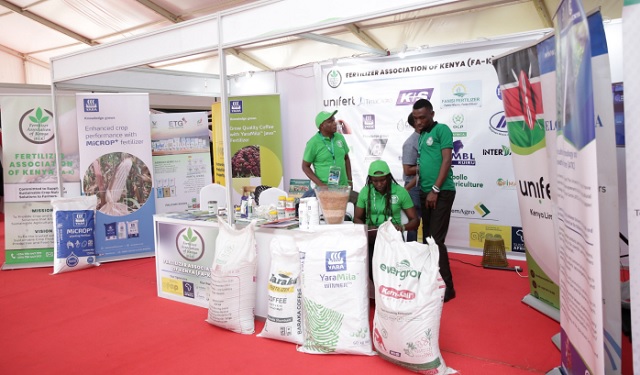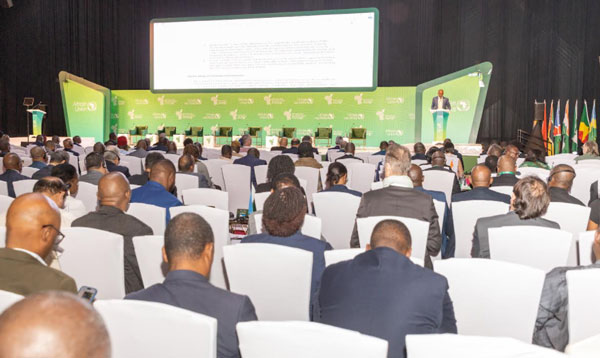
Africa holds 60% of world’s arable land but struggles with crop productivity
Nairobi, Kenya | RONALD MUSOKE | In a bid to eradicate persistent hunger across the continent, African leaders who met recently in Nairobi, pledged to increase domestic production and distribution of high-quality fertilizers by threefold within the next ten years. The initiative, the leaders said, is aimed at enhancing availability and reduction of fertilizer costs for smallholder farmers.
“We pledge that by 2034, at least 70% of smallholder farmers across the continent will receive tailored agronomic recommendations. These will be specific to individual crops, soil types, and climatic conditions, ensuring more efficient and sustainable fertilizer use,” declared the leaders in a statement concluding the threeday Fertilizer and Soil Health Summit, held from May 7-9 in Nairobi under the auspices of the Kenyan government and the African Union.
The leaders pledged to prioritize local production and blending of mineral fertilizers using locally available raw materials. They also agreed to strengthen research and development on the utilization of inorganic and organic fertilizers by resuscitating the African Centre for Fertilizer Development in Harare, Zimbabwe, as well as provide incentives for local production, utilization and recycling of organic resources.
The summit held under the theme, “Listen to the Soil” attracted thousands of delegates including several African heads of state and government; ministers of foreign affairs, ministers of agriculture, high ranking officials from development partner institutions, NGOs, the private sector, smallholder farmer organizations and the media.
“In the context of the continued negative impacts of climate change, the theme of this summit is particularly pertinent. We must listen to the land,” said Moussa Faki Mahamat, the Chairperson of the African Union Commission.
“Africa is experiencing accelerated soil degradation, including through desertification and floods as well as seeing in East Africa and here in Kenya, often alternatively either droughts or floods which in turn reduces the production and productivity of the African agricultural sector.”
Faki told the attentive African leaders and delegates that the current pace of soil degradation in Africa has attained a threshold that requires proactive attention and action from all, to halt the degradation and commence effective soil health.
“What is clear is that Africa’s agricultural production capacity falls way below global norms. Equally important are the causes of soil health degradation on the continent,” Faki said, “It is therefore up to us to harness our collective determination and resources in addressing soil health and fertilizer use in a holistic manner if we are to achieve sustainable food systems on our continent.”
“Our strategic frameworks are in place and we have the capacity to work together to produce the fertilizers and other agricultural inputs. We need to. Let us therefore give ourselves the necessary political means to address the challenges to our food sovereignty,” Faki added.
Kenya’s President, William Ruto, who hosted the summit noted that all across Africa, people continue to face numerous challenges that hinder their efforts and investments in enhancing agricultural productivity.
These challenges, President Ruto said, include; inadequate fertilizer application, extreme climate adversities such as flooding and intense drought, and extensive land degradation, among others, all pointing to the broader issue of poor soil health, central to the discussions at the summit.
He said the recent global economic crises – compounded by supply chain disruptions from the COVID-19 pandemic and geopolitical dynamics – have worsened fertilizer affordability and availability, disrupting agriculture and resulting in reduced acreage and lower yields.
President Ruto told his colleagues that in their pursuit of the green revolution, it is crucial to note that Africa possesses over 60% of the world’s uncultivated arable land, yet it operates below its agricultural potential.
“This vast potential underscores our ability and obligation to transform Africa from a hungry continent into a self-sufficient global breadbasket,” he said, “Additionally, fluctuating fertilizer prices and supply chain disruptions, exacerbated by conflict in producing regions, demand deep reflection on securing adequate, affordable, and sustainable fertilizer production and supply across Africa.”
“Therefore, in the face of prevailing challenges, our commitment to achieving Sustainable Development Goal number 2 – ending hunger, ensuring food security, improving nutrition, and promoting sustainable agriculture must be unwavering.
“This commitment resonates boldly in our Agenda 2063, where we pursue an agricultural revolution through modern, sustainable practices. Our focus should not only be on increasing usage but also on ensuring its judicious application to revitalize responsive soils and rehabilitate degraded ones.”
He added: “Despite our current situation falling short of our ambitions outlined in the Abuja Declaration, SDG2, and Agenda 2063, there are reasons for optimism. It is encouraging to see several African nations making strides in fertilizer production, particularly phosphate fertilizers.”

The Nairobi Ferilizer and Soil Health summit took place exactly 18 years since the inaugural summit on fertilizer use in Africa was held in Abuja– the Nigerian federal capital. The Abuja Summit resolved under a 12-step resolution to provide a mechanism for increasing fertilizer consumption in Africa to help the continent leapfrog the green revolution. At the time, average fertilizer application across the continent was just 8kg/hectare and the leaders resolved to raise it to 50kg/hectare.
Africa’s fertilizer usage
However, Amb. Josefa Sacko, the African Union Commissioner for Agriculture, Rural Development, Blue Economy and Sustainable Environment told the summit in Nairobi that fertilizer consumption in Africa had only risen from 8kg/ha to below 25kg/ha since 2006, far below the 50kg/ha target.
“Despite multiple efforts, Africa falls short of the Abuja Declaration targets; despite producing around 30 million metric tonnes of mineral fertilizer annually, many African countries still heavily rely on imports, particularly non-phosphate-based fertilizers, leaving them vulnerable to market shocks,” Amb. Sacko said.
For some time now, the African Union has been rallying its member states to improve their food sovereignty by raising agricultural productivity as the continent’s population tilts towards the 2.4 billion mark over the next 25 years. But, as things stand, SubSaharan Africa has the lowest fertilizer usage in the world insufficient to replace soil nutrients lost every year to crop production.
Statistics from the global lender, the World Bank, show that fertilizer consumption (kilogrammes per hectare) of arable land ranges from 0.03kg/ha in Sudan and 1.04kg/ ha in Somalia to 543kg/ha in Seychelles and 542.5kg/ha in Egypt, the highest figure recorded by an African nation.
Indeed, only 10 African countries have been able to surpass the Abuja Declaration targets with Egypt and Seychelles leading followed by Mauritius (186kg/ha), South Africa (105kg/ha), Malawi (97kg/ha), Zambia (64kg/ha), Kenya (61kg/ha), Botswana (60kg/ ha), Eswatini (58kg/ha) and Morocco (55kg/ ha).
Dr. Jean Jacques Muhinda, the Regional Manager for East Africa at the Alliance for Green Revolution in Africa (AGRA), a non-profit that seeks to catalyze agriculture transformation in Africa, noted during a side event at the summit that the continental consumption of inorganic fertilizers represents just 3% of the world’s total, with average fertilizer application estimated at 17-19kg of nutrients per hectare of crop land against the world average of 135kg/hectare.
According to AGRA, northern Africa is the only region that meets its local demand for inorganic fertilizers. The region produces more than 90% of African fertilizers (the continent produces about 4% of world fertilizers).
Growing fertilizer demand
Dr. Muhinda noted that fertilizer demand for Africa as a whole is projected to hit 8 million metric tonnes of nutrients per annum in 2023/24. However, close to 90% of the fertilizer consumed in sub-Saharan Africa is still imported. In fact, between 2018-2022, sub-Saharan Africa imported fertilizers valued at US$4.5bn.
The fact that most of the fertilizer consumed across Africa is imported partly explains why fertilizer use remains limited. Dr. Muhinda, said fertilizer costs in subSaharan Africa are at least four times more expensive than they are in Europe.
Yet, the clamour to build fertilizer factories may still be out of reach of many African countries. He noted that fertilizer production is capital intensive and is often characterized by substantial economies of scale.

For instance, a modern ammonia/urea complex capable of producing 550,000 tonnes of urea per year costs more than US$350 million to build. He said until African fertilizer markets become large enough to justify investment in large scale production facilities, importing will remain the most cost-effective strategy.
Yet that is not the only constraint. Surprisngly, international shipping costs remain considerably lower than domestic transport costs of the often bulky. For example, Dr. Muhinda noted how a metric tonne of fertilizer can be shipped 11,000km from a manufacturing plant in the U.S to Mombasa in Kenya for about US$50.
But, transporting the same metric tonne of fertilizer less than 1,000km from Mombasa to Kampala, in Uganda, would cost an additional US$80-90. In order to ship it another 300km to Mbarara in southern Uganda from Kampala, it would set back the importer two-and-half times the cost of shipping it from the U.S manufacturing plant to Mombasa.
He says local blending could then offer some advantages over importing preblended fertilizer. This is because, first, it can cost significantly less to purchase single nutrient components in bulk. Secondly, compound fertilizers can be produced for crops in specific localities.
Dr Muhinda says well-designed and properly enforced regulations could also play a critical role in opening fertilizer markets. “Markets can also be opened by lowering trade barriers, integrating market information systems across national borders, facilitating transnational mergers among national fertilizer companies and creating Market institutions that integrate multiple national markets.”
Not all gloom and doom
Meanwhile, Sebastian Nduva, the Programme Lead for Africa Fertilizer, a data initiative under the International Fertilizer Development Centre (IFDC), an international agency that provides market information and intelligence across different fertilizer markets on the continent told The Independent on the sidelines of the summit that over the last 18 years, several African countries have indeed made good strides; increasing fertilizer use from 8kg/ha to 34kg/ ha according to their data.
“This is something commendable; in as much as we have not attained the target (50kg/ha); it is a step in the right direction.” Still, Nduva told The independent that for Africa to achieve the target, several interventions will have to be made: policy discussions need to be made, extension services and knowledge to the farmers need to be enhanced and interventions have to be made across the board to incentivize proper consumption of fertilizer.

But will the African leaders new pledge have tangible results this time?
Several leaders at the Nairobi summit agreed that things must be done different this time for the continent to improve its food security situation. Indeed, it is not the first time African leaders are coming up with commitments to accelerate agricultural productivity on the continent. At the second ordinary assembly of the African Union held in 2003 in Maputo, Mozambique, African leaders endorsed the “Maputo Declaration on Agriculture and Food Security.”
That declaration contained several important decisions and prominent among them was the commitment by the leaders to allocate at least 10% of their annual national budgets to agriculture and rural development policy implementation within five years.
In June 2014, African leaders once again declared their commitment to end hunger in Africa by 2025. The declaration on accelerated agricultural growth and transformation for shared prosperity and improved livelihoods focused on accelerating agricultural growth by at least doubling current agricultural production levels, by the year 2025.
In September, 2020, during the Alliance for a Green Revolution in Africa Forum (AGRF), the African Union Commission issued a call for an ambitious long-term effort to systematically improve the health and productivity of Africa’s soils.
“We are here almost 20 years since the decision taken at the Africa Fertilizer Summit in Abuja and yet today, we face the same challenge as it was then,” noted Maria Helena Semedo, the Deputy DirectorGeneral at the Food and Agriculture Organization of the United Nations (FAO).
“Our task is big and we need action now.
We must increase availability, accessibility, affordability and quality of fertilizer and their efficient use,” she said, “We must try to measure science and innovation for soil management and health. We must deploy integrated solutions considering soil fertility status, sustained by fertilizer use, biodiversity resilience, irrigation and water management.”
For Dr Cary Fowler, the Special Envoy for Global Food Security, U.S Department of State, prioritizing soil health, sustainable agricultural practices and enhanced productivity will be key in achieving the continental’s lofty ambitions of boosting agricultural productivity.
“It’s clear that the right crops planted in the appropriate soils and deploying effective farm management practices are crucial for improving agricultural productivity and building resilience against climate change,” he said.
However, Scott Wallace, the CEO of Wallace & Associates who worked for IFDC in Nigeria in 2006 during the first fertilizer summit told The Independent that a lot has changed over the last 18 years in the African market although a lot is still needed.
“We need to develop national strategies based on the Declaration so that we are able to take a very high-level issue and bring it down at country level. That will be the next critical step although it will be hard since we have to get the donors, governments and the private sector at the table.”
 The Independent Uganda: You get the Truth we Pay the Price
The Independent Uganda: You get the Truth we Pay the Price



